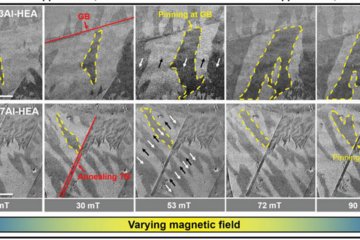All genres
2441.
Thesis - PhD
Mechanism Maps, Mechanical Properties, and Flow Behavior in High-Manganese TRIP/TWIP and TWIP steels. Dissertation, RWTH Aachen, Aachen, Germany (2011)
2442.
Thesis - PhD
Fundamental Research into the Role of Intermetallic Phases in Joining of Aluminium Alloys to Steel. Dissertation, Ruhr-University Bochum, Bochum, Germany (2011)
2443.
Thesis - PhD
Deformation and recrystallization behaviour of Fe–Mn–C alloys. Dissertation, RWTH Aachen, Aachen, Germany (2011)
2444.
Thesis - PhD
Micromechanical Modeling of Gamma-TiAl - based alloys. Dissertation, RWTH Aachen, Aachen, Germany (2010)
2445.
Thesis - PhD
Constitutive modeling of fcc single crystals and experimental study of mechanical size effects. Dissertation, RWTH Aachen, Aachen, Germany (2010)
2446.
Thesis - PhD
Strain rate sensitivity of automotive sheet steels: Influence of plastic strain, strain rate, temperature, microstructure, bake hardening and pre-strain. Dissertation, RWTH Aachen, Aachen, Germany (2010)
2447.
Thesis - PhD
Micromechanical Characterization of Ductile Damage in Sheet Metal. Dissertation, TU Delft, Delft, The Netherlands (2010)
2448.
Thesis - PhD
Evolution of microstructure during long-term creep of a tempered martensite ferritic steel. Dissertation, Ruhr-University Bochum, Bochum (2009)
2449.
Thesis - PhD
Modelling of Microstructure Evolution and Crack Opening in FCC Materials under Tension. Dissertation, Wollongong University, Wollongong New South Wales [Australia] (2009)
2450.
Thesis - PhD
Mechanical Characterization of Viscoelastic-Plastic Soft Matter using Nanoindentation. Dissertation, Ruhr-University Bochum, Bochum [Germany] (2009)
2451.
Thesis - PhD
High Resolution Investigation of Texture Formation Process in Diamond Films and the Related Macro-Stresses. Dissertation, Ruhr-University Bochum, Bochum [Germany] (2009)
2452.
Thesis - PhD
Zusammenhang zwischen Mikrostruktur, Schädigungsverlauf und mechanischen Eigenschaften bei TRIP Stählen. Dissertation, RWTH Aachen, Aachen, Germany (2008)
2453.
Thesis - PhD
Untersuchung metallphysikalischer und messtechnischer Grundlagen zur Rekristallisation und Erholung mikrolegierter IF Stähle. Dissertation, RWTH Aachen, Aachen, Germany (2008)
2454.
Thesis - PhD
Modeling and Experiment on Mo-based high temperature composites. Dissertation, Ecole Centrale Paris, Laboratoire for Materials, Paris [France] (2008)
2455.
Thesis - PhD
Kristallographische Texturen und richtungsabhängige mechanische Eigenschaften des Exoskeletts des amerikanischen Hummers sowie Texturen weiterer Biomaterialien. Dissertation, RWTH Aachen, Aachen, Germany (2008)
2456.
Thesis - PhD
Microstructure and mechanical properties of the exoskeleton of the lobster Homarus americanus as an example of a biological composite material. Dissertation, RWTH Aachen, Aachen, Germany (2008)
2457.
Thesis - PhD
Experimental and theoretical investigation of nanoindentation in a Cu single crystal. Dissertation, RWTH Aachen, Aachen, Germany (2008)
2458.
Thesis - PhD
Micromechanical Modeling and Simulations of Tranformation-Induced Plasticity in Multiphase Carbon Steels. Dissertation, TU Delft, Delft, The Netherlands (2008)
2459.
Thesis - PhD
Korrelation von mechanischen Eigenschaften und Kristallorientierung auf mikroskopischer und nanoskopischer Ebene. Dissertation, RWTH Aachen, Aachen, Germany (2008)
2460.
Thesis - PhD
Characterization of the Microstructure, Grain Boundaries and Texture of Nanostructured Electrodeposited CoNi by use of EBSD. Dissertation, RWTH Aachen, Aachen, Germany (2007)











